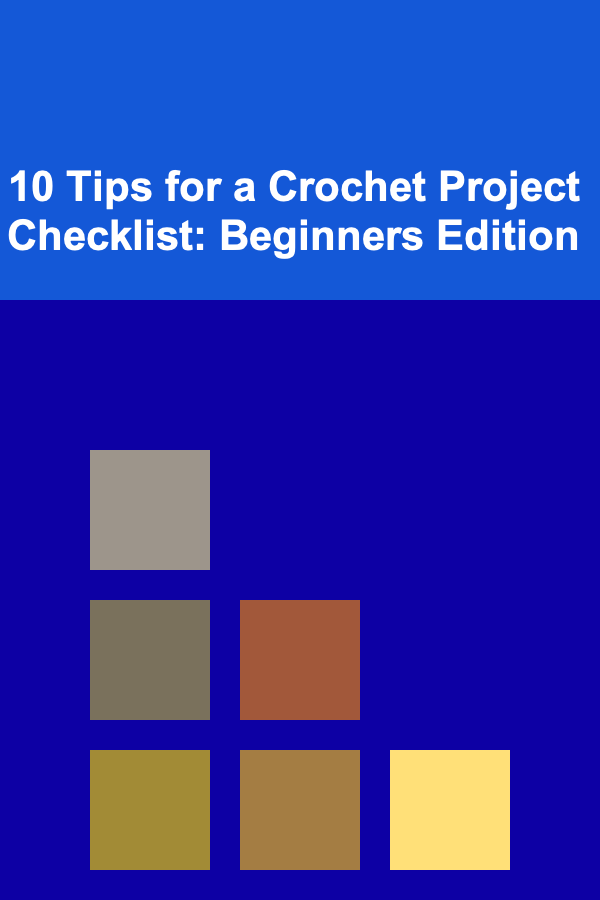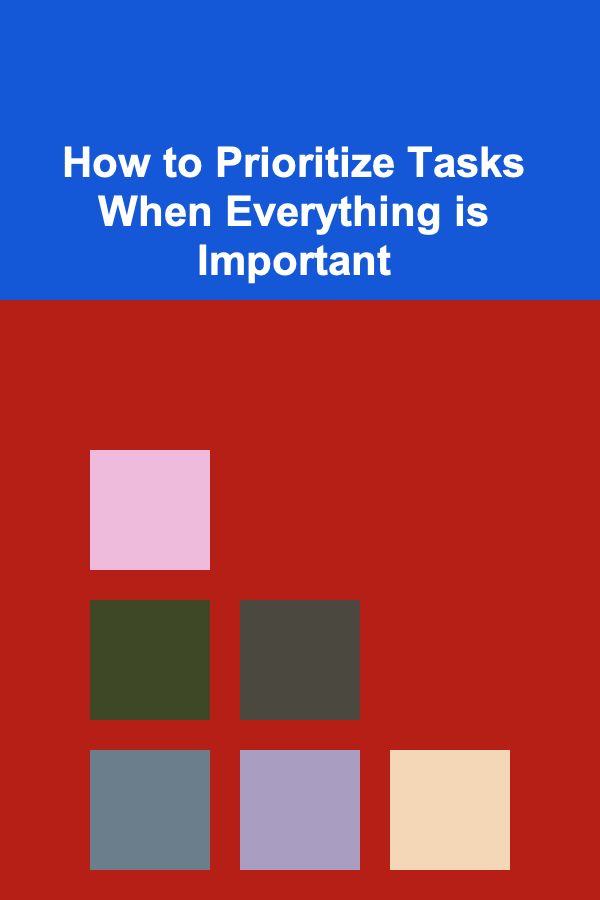
10 Tips for a Crochet Project Checklist: Beginners Edition
ebook include PDF & Audio bundle (Micro Guide)
$12.99$10.99
Limited Time Offer! Order within the next:

Crocheting is a delightful and rewarding hobby, perfect for crafting everything from cozy blankets and garments to intricate home decor. For beginners, the world of crochet can be a bit overwhelming, but once you get the hang of it, it becomes a fulfilling and enjoyable skill to have. Whether you're new to the craft or looking for a refresher, having a crochet project checklist can keep you organized and ensure that you have everything you need to succeed.
In this article, we'll walk you through 10 essential tips to create a crochet project checklist that will guide you through the process from start to finish. These tips will help you plan, execute, and finish your crochet projects with confidence.
Choose the Right Yarn for Your Project
The first step in any crochet project is selecting the appropriate yarn. Yarn comes in a variety of fibers, weights, and colors, each suited for different types of projects. Here's what you need to consider:
1.1 Yarn Weight
Yarn weight refers to the thickness of the yarn, which directly impacts the appearance and feel of your finished project. Common yarn weights include:
- Fingering (Weight 1): Perfect for delicate, lightweight projects like lace shawls or socks.
- Sport (Weight 2): Slightly thicker, great for light garments and baby items.
- Worsted (Weight 4): One of the most common weights, suitable for blankets, scarves, and sweaters.
- Bulky (Weight 5): Ideal for faster projects, like chunky scarves and cozy blankets.
- Super Bulky (Weight 6): Best for quick, thick projects like oversized blankets and rugs.
1.2 Yarn Fiber
The fiber content of your yarn plays a significant role in the texture and durability of your project. Here are a few options:
- Acrylic: Affordable, versatile, and machine washable. Ideal for beginners and projects that need to withstand regular use.
- Cotton: Lightweight and breathable, perfect for summer garments and dishcloths.
- Wool: Soft, warm, and naturally stretchy, making it great for colder weather projects like hats and scarves.
- Blends: Yarns made from a combination of fibers, offering the benefits of multiple materials, such as wool-acrylic blends that are soft yet easy to care for.
Selecting the right yarn for your project ensures that your finished piece will have the right texture, weight, and feel for its intended use.
Pick the Right Crochet Hook Size
The size of your crochet hook should correspond to the weight of your yarn and the pattern you're working on. Generally, each yarn comes with a recommended hook size indicated on the label, but here are some general guidelines:
- Fingering or Lace Yarn : Use a 2.25 mm to 3.5 mm hook.
- Sport or DK Yarn : A 3.5 mm to 4.5 mm hook works best.
- Worsted Yarn : Typically requires a 5.0 mm to 6.0 mm hook.
- Bulky Yarn : You'll need a 6.5 mm to 9.0 mm hook.
- Super Bulky Yarn : Opt for a 9.0 mm or larger hook.
Choosing the correct crochet hook size ensures that your stitches are consistent and your project maintains the right shape and texture.
Learn Basic Stitches and Techniques
Before starting your project, ensure you're familiar with at least a few basic crochet stitches. Some essential stitches include:
- Chain Stitch (ch): The foundation for most crochet projects.
- Slip Stitch (sl st): Used for joining or moving between stitches without adding height.
- Single Crochet (sc): A tightly worked stitch that's great for solid, dense fabric.
- Half Double Crochet (hdc): A versatile stitch that creates a fabric slightly more textured than single crochet.
- Double Crochet (dc): A taller stitch that's perfect for creating open and airy fabrics.
Learning these fundamental stitches gives you the foundation to tackle almost any crochet project.
Gauge Swatch: Why It's Important
One of the most important steps for beginners is checking your gauge. Gauge refers to the number of stitches and rows per inch that you achieve with a specific yarn and hook combination. It's essential for ensuring that your project turns out the correct size.
Here's why you should always check your gauge:
- Size Accuracy: If your gauge is off, the finished piece might be too big or too small, especially for garments.
- Fit and Comfort: In projects like sweaters or hats, using the right gauge ensures that the item fits comfortably.
- Consistency: Matching the gauge used in a pattern ensures that your project will have a similar look and texture.
To check your gauge, crochet a small swatch using the stitch pattern from your project. Measure the swatch against the gauge specifications in the pattern, and if it doesn't match, adjust your hook size until it does.
Understand the Pattern and Read It Carefully
When you're following a crochet pattern, it's essential to read through the entire pattern before beginning. This helps you understand the structure of the project and any special instructions, such as:
- Stitch abbreviations : Crochet patterns often use abbreviations for stitches, such as sc for single crochet or dc for double crochet. Be sure to familiarize yourself with these abbreviations.
- Yarn usage: Patterns may indicate how much yarn is required for the project, as well as the type of yarn needed.
- Shaping and increases: Some patterns include instructions for shaping the item, such as increasing or decreasing stitches. Make sure you understand these techniques before starting.
- Finishing techniques: Read ahead to ensure you know how to finish the project, whether it involves joining pieces, weaving in ends, or adding decorative borders.
Understanding your pattern fully before you start will prevent mistakes and confusion as you go along.
Keep Your Workspace Organized
A tidy workspace is crucial for keeping your crochet project on track. Here's how to stay organized:
- Yarn Storage: Keep your yarn organized by using storage bins, yarn bowls, or clear containers. This will help you easily access the colors and weights you need.
- Crochet Hook Case: Invest in a hook case or organizer to keep all your crochet hooks in one place, making it easier to find the right one for your project.
- Project Bag: Use a project bag to store your current crochet project, along with any tools, yarn, and pattern instructions. This keeps everything in one place and makes it easier to transport your project if you're on the go.
Being organized will save you time and frustration, ensuring a smooth crochet experience.
Take Your Time and Stay Patient
Crocheting, like any craft, requires patience and practice. As a beginner, don't rush through your project. Take your time to enjoy the process and avoid making mistakes. If you make an error, don't be discouraged---simply undo the stitches and try again. Each mistake is an opportunity to learn and improve.
Make Use of Stitch Markers
Stitch markers are invaluable tools for beginners. They can help you keep track of:
- Round markers: These are helpful for joining rounds, especially in circular crochet projects like hats or amigurumi.
- Row markers: If you're working in rows, use markers to indicate the beginning of each row to help you avoid losing your place.
- Pattern repeats: If a pattern has a repeating sequence of stitches, place a marker to keep track of where you are in the repeat.
Using stitch markers can help you maintain the accuracy of your crochet work and make it easier to spot mistakes.
Practice Finishing Techniques
Once you've completed your crochet project, it's time to finish it off. Proper finishing techniques ensure that your work looks polished and professional. Here are a few techniques to master:
- Weaving in Ends: After completing your project, you'll need to weave in any loose yarn ends to prevent them from unraveling. Use a yarn needle to carefully thread the ends into the stitches, making sure to secure them tightly.
- Blocking: Blocking is the process of wetting and reshaping your project to even out the stitches and achieve the desired size and shape. This is particularly important for lacework or projects with irregular stitches.
Perfecting your finishing techniques gives your crochet work a clean, finished look.
Enjoy the Process and Experiment
Crocheting is all about creativity and enjoyment. Don't be afraid to experiment with new stitches, yarns, and patterns. The more you practice, the better you'll get at reading patterns, following techniques, and producing beautiful pieces. Try different projects, and remember that every crochet piece you complete is a step toward mastering the craft.
Conclusion
Crocheting is a fun and fulfilling craft that's perfect for beginners and experts alike. By following these 10 tips for your crochet project checklist, you can set yourself up for success from the start. Remember to choose the right yarn and hook, learn the basics, keep your workspace organized, and enjoy the process. With time and patience, you'll build your skills and confidence, creating beautiful, handmade projects that will bring you joy and satisfaction. Happy crocheting!
Reading More From Our Other Websites
- [Home Party Planning 101] How to Create the Ultimate DIY Cocktail Bar for Your Party
- [Home Cleaning 101] How to Create a Spring Cleaning Checklist
- [Organization Tip 101] How to Create an Action Plan for Time Management Improvement
- [Personal Care Tips 101] How to Choose the Best Antiperspirant for Your Skin Type
- [Personal Financial Planning 101] How to Use the Best Investment Apps for Easy and Smart Investing
- [Personal Financial Planning 101] How to Manage Your Cash Flow for a Stress-Free Life
- [Home Storage Solution 101] How to Use Baskets and Bins to Keep Your Home Tidy and Neat
- [Beachcombing Tip 101] Eco‑Friendly Finds: Turning Beachcombing Discoveries into Sustainable Crafts
- [Personal Care Tips 101] How to Use Mouthwash to Relieve Dry Mouth
- [Mindful Eating Tip 101] From Plate to Heart: Building Stronger Family Bonds Through Mindful Eating

How to Build Wealth Early in Your Career for Long-Term Success
Read More
How to Create a Family Photo Wall with Style
Read More
How to Prioritize Tasks When Everything is Important
Read More
How to Store Serving Utensils and Platters Neatly
Read More
How to Use Credit Cards Wisely to Avoid Debt
Read More
Optimizing Inventory Management: A Comprehensive Guide for Supply Chain Analysts
Read MoreOther Products

How to Build Wealth Early in Your Career for Long-Term Success
Read More
How to Create a Family Photo Wall with Style
Read More
How to Prioritize Tasks When Everything is Important
Read More
How to Store Serving Utensils and Platters Neatly
Read More
How to Use Credit Cards Wisely to Avoid Debt
Read More